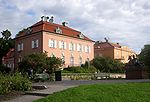- Axel Wenner-Gren
-
 Axel Wenner-Gren
Axel Wenner-Gren
 Wenner-Gren Center, Stockholm, 1960
Wenner-Gren Center, Stockholm, 1960
 "Wenner-Gren palace", Diplomatstaden, Stockholm, 2008
"Wenner-Gren palace", Diplomatstaden, Stockholm, 2008
Axel Lennart Wenner-Gren (5 June 1881 - 24 November 1961) was a Swedish entrepreneur and one of the wealthiest men in the world during the 1930s.
The basis of Wenner-Gren's fortune was his early appreciation that the industrial vacuum cleaner could be adapted for domestic use. Soon after the First World War he persuaded the Swedish lighting company Electrolux, for which he then worked (securing the contract to floodlight the opening ceremony of the Panama Canal, among other successes), to buy the patent to a cleaner and to pay him for sales in company stock. By the early 1930s, Wenner-Gren was the owner of Electrolux, and the firm was a leading brand in both vacuum cleaner and refrigerator technology. Wenner-Gren also diversified his interests into the ownership of newspapers, banks and arms manufacturers, and acquired many of the holdings of the disgraced safety-match tycoon Ivar Kreuger.
Wenner-Gren was reported to be a friend of Hermann Göring, whose first wife was a Swede, and in the late 1930s convinced himself that he could avert the coming world war by acting as a conduit between Göring and the British and American governments. His efforts proved unsuccessful, with all parties regarding him as a self-promoting nuisance, and, more to the point, one without much influence on the plans of the Nazi regime.
A disconsolate Wenner-Gren retired to his estate in the Bahamas, Hog Island (now Paradise Island), where he became friendly with the islands' governor, the Duke of Windsor. Early in the war his rumored friendship with Göring and the suspected German sympathies of the Duke led first the Americans and, following their lead, the British, to place him on an economic blacklist, enabling them to freeze his assets in Nassau. There proved to be little foundation to their suspicions that Wenner-Gren was a Nazi agent, notwithstanding the appearance of his yacht (the world's largest) along with ships from the Allied Navies at the site of the sinking of the liner SS Athenia on the first day of the war. Wenner-Gren's yacht the Southern Cross rescued over three hundred survivors of the sinking and transferred some to nearby Allied ships and others continued to the U.S.
Among Wenner-Gren's other interests were monorail train systems. His company, ALWEG, built the original Disneyland Monorail System in 1959 and the Seattle Center Monorail in 1962. Wenner-Gren continued his fascination with speculative railway projects, as he collaborated with Canadian W.A.C. Bennett to build a railway north from Prince George into the untapped Peace River, Rocky Mountain Trench and eventually Alaska. Parts of the railway were built by the Pacific Great Eastern Railway after Wenner-Gren's death, including the needless Fort Nelson branch, yet the meeting produced outcomes lasting to this day. The interest in the north spurred a spate of mega-industrial projects in the region: the Bennett Dam flooding vast valleys, gas pipelines and plants at Taylor, coal mines and pulp mills.
In the 1950s, Axel Wenner-Gren also got involved in the early computer business. For a railroad project connecting California with Alaska, he got in touch with Glenn Hagen, previously an engineer with Northrop Aircraft, who had founded Logistics Research in Redondo Beach outside Los Angeles, developing computers based on magnetic drum memory. In November 1952, Wenner-Gren helped the company to incorporate. He soon controlled the company and renamed it ALWAC (the Axel L. Wenner-Gren Automatic Computer). The model ALWAC II was shipped in June 1954 and model III in December 1955. In 1956 and 1957, the model ALWAC III-E was considered a competitor to the IBM 650, having fewer parts and good economy, but no more than 30 units seem to have been delivered.[1] Soon after this, magnetic drum machines were made obsolete by the introduction of the magnetic core memory. The follow-up ALWAC 800 was a failed design that never went beyond prototype, using not only core memory but also magnetic logic (a combination of semicondutor diodes and magnetic cores, cf. Hewitt Crane), and presold contracts nearly ruined the company. Development was transferred to Sweden in 1958. The next model, named Wegematic 1000, a slight upgrade of the III-E, was shipped in 1960. Only a dozen were delivered and half of them were give-aways to universities, including one unit for the Weizmann Institute in Israel. In exchange, Wenner-Gren received several honorary titles.
Wenner-Gren also founded and endowed The Viking Fund in 1941, an organization supporting anthropological research. In 1941, the endowment funded the Wenner-Gren Aeronautical Research Laboratory, now called the Wenner-Gren Laboratory at the University of Kentucky. The lab has since changed its focus to Biomedical Engineering[2]. The Viking fund was later re-named the Wenner-Gren Foundation for Anthropological Research.
References
Notes
- ^ Hallberg, 2007
- ^ "University of Kentucky: Center for Biomedical Engineering". University of Kentucky. http://www.cbme.uky.edu/history.htm. Retrieved 2009-11-09.
Litterature
- Hallberg, Tord Jöran (2007). IT-gryning. Svensk datahistoria från 1840- till 1960-talet. Studentlitteratur, Sweden. ISBN 978-91-44-03501-7. http://www.itgryning.se/.
- Santiago Bolaños Guerra & Jorge Ruiz Esparza, Axel Wenner-Gren. El vikingo que llegó del frío (The Viking Who Went South From the Cold), Mexico, 2008, 407 pages.
Santiago Bolaños Guerra en colaboración con Jorge Ruiz Esparza "La Cruz del Sur" Axel Wenner-Gren el espía que México protegió. Ediciones B 322 Páginas. 2009 México.
Categories:- 1881 births
- 1961 deaths
- Swedish businesspeople
Wikimedia Foundation. 2010.
